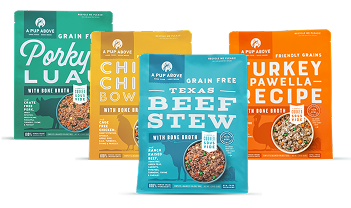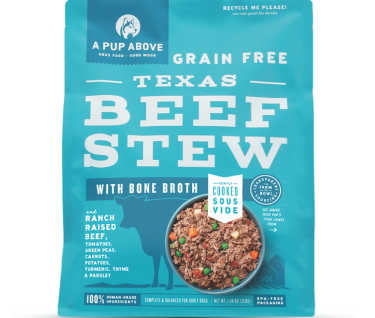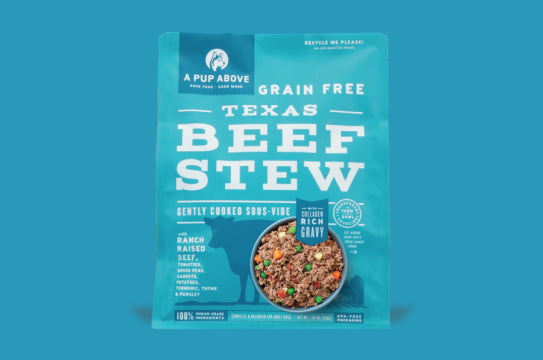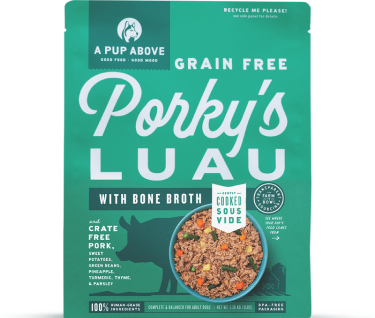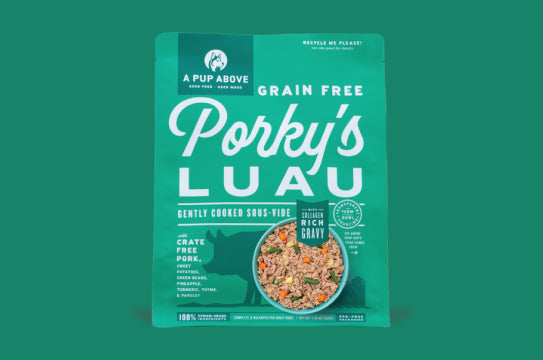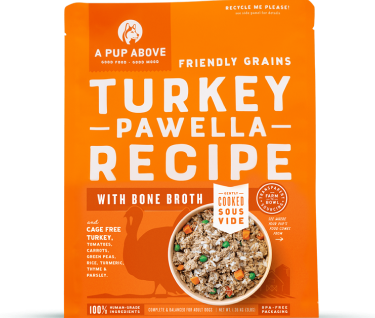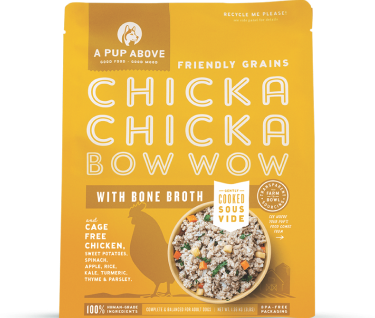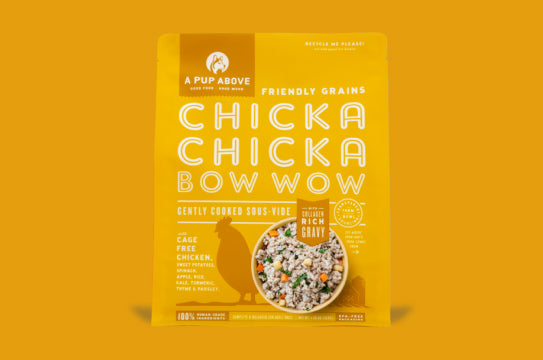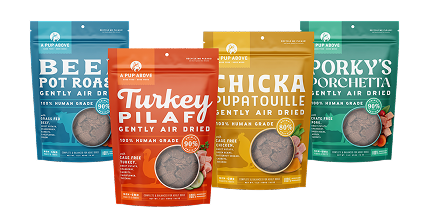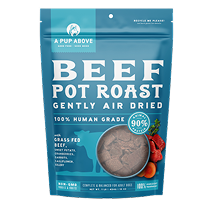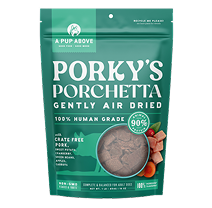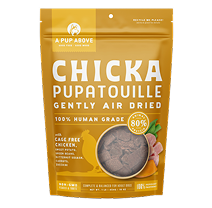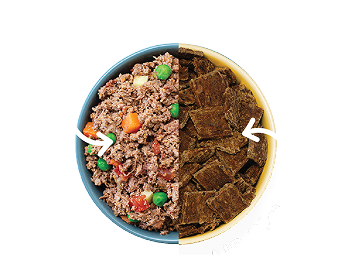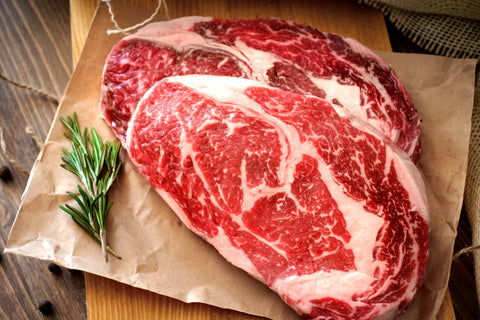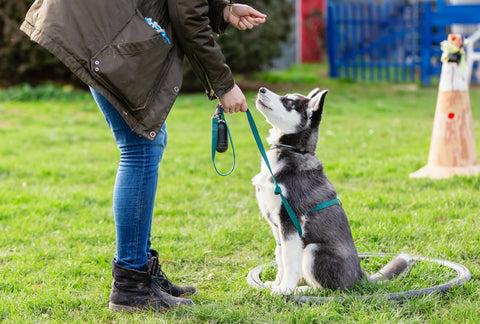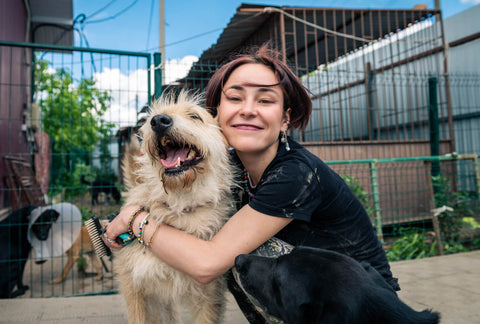
What To Know About Dental Disease in Dogs
Table of Contents
Key Takeaways:
-
Dental disease is one of the most common health issues in adult dogs. If plaque isn’t removed, it hardens into tartar, which irritates the gums and leads to inflammation, known as gingivitis. Over time, this can progress to more serious issues like infected gums, tooth loss, or damage to the bone supporting the teeth.
-
Some common signs of dental disease in dogs include bad breath, red gums, signs of discomfort or pain, or a decrease in chewing behavior or appetite.
-
You can help prevent dental issues in your dog by brushing their teeth, offering dental chews, feeding a balanced diet, or looking into dental sprays or water additives.
Dental health isn’t always the first thing that comes to mind when we think about our dogs’ well-being, but it should be. Just like humans, dogs are at risk of plaque buildup, gum disease, and even tooth loss if their oral care is neglected. What starts as mild bad breath can turn into something much more serious, affecting their appetite, comfort, and even long-term health.
The tricky part is that dental disease in dogs often goes unnoticed until it's advanced. But the good news is that it’s largely preventable with the right habits at home and regular vet care.
At A Pup Above, we believe that staying on top of your dog’s dental hygiene protects their teeth and their whole-body health. Think of it as one more way to help them live a healthier, happier life.
What Is Dental Disease in Dogs?
Dental disease, also known as periodontal disease, is one of the most common health issues in adult dogs. It begins when plaque (a sticky film made of bacteria) starts to collect on the teeth.
If it’s not removed, it hardens into tartar, which irritates the gums and leads to inflammation, known as gingivitis. Over time, this can progress to more serious issues like infected gums, tooth loss, or damage to the bone supporting the teeth.
Most cases of dental disease develop gradually, which makes it easy to overlook in the early stages. You might not notice anything is wrong until your dog’s breath worsens or they seem less interested in eating crunchy food.
Understanding how this process works is the first step to catching problems early and preventing them altogether. With some consistent care, you can keep your dog’s teeth and gums in much better shape for the long run.
What Are Common Signs of Dental Disease in Dogs?
Dental disease in dogs often starts subtly, making it easy to miss the early warning signs.
Bad Breath
One of the most obvious signs is bad breath. This isn’t just “doggy breath” but an unpleasant odor that’s a sign of bacterial buildup in the mouth. If your dog’s breath smells particularly foul, it’s a red flag.
Red Gums
Another common symptom is red or bleeding gums, especially when you touch your dog’s mouth or when they eat. Tartar buildup on the teeth, which can look yellow or brown, is a clear sign of poor oral hygiene.
Signs of Discomfort
You might also notice your dog pawing at their mouth or chewing on one side, which can be an indicator of discomfort or pain. If your dog is eating less, avoiding hard food, or drooling more than usual, these could also be signs of dental disease. Some dogs may become more irritable or lethargic as the pain from their teeth or gums increases.
Decrease in Chewing
Finally, a decrease in chewing on toys or an unwillingness to eat could suggest that dental pain is affecting your dog’s daily routine. If you notice any of these symptoms, it’s time to schedule a vet appointment to get ahead of potential dental problems.
What Causes Dental Disease in Dogs?
Dental disease in dogs often starts with plaque buildup. If not removed, plaque hardens into tartar, which irritates the gums and leads to gum disease. Over time, this can result in tooth loss and more severe health issues.
The primary cause of plaque is poor oral hygiene, especially when regular brushing isn’t part of the routine. Certain dog breeds are more prone to dental disease as well.
Small breeds, in particular, are at a higher risk due to their smaller mouths and tightly packed teeth, which can make plaque buildup harder to remove. Without regular cleaning, these factors contribute to the development of dental disease in dogs.
What Are the Risks and Health Problems Linked to Poor Dental Hygiene?
Neglecting dental hygiene in dogs goes beyond just bad breath; it can lead to a range of serious health problems. One of the biggest risks is gum disease, which can progress to the point where it causes tooth loss.
But the impact doesn’t stop there. Bacteria from infected gums can enter the bloodstream and spread to vital organs, including the heart, kidneys, and liver, leading to serious conditions like heart disease and kidney failure.
Chronic dental problems can also cause pain and discomfort, which affects your dog’s overall quality of life. They may become reluctant to eat or show signs of irritability. In severe cases, untreated dental disease can even lead to infection that requires expensive and invasive treatments. By preventing dental disease, you’re also protecting your dog’s long-term health.
How Can You Help Prevent Dental Disease at Home?
Preventing dental disease in dogs starts at home with a solid oral care routine. This section will cover some effective ways to keep your dog’s teeth and gums in top condition.
Brush Your Dog’s Teeth
Just like humans, regular brushing is the most effective way to remove plaque. Use a dog-specific toothbrush and toothpaste (never human toothpaste because it contains harmful ingredients for pets). Aim to brush your dog’s teeth a few times a week or even daily if possible.
Offer Dental Chews
High-quality dental chews are a great way to help scrape plaque off your dog’s teeth while also satisfying their chewing instincts. Choose chews that are designed specifically for dental health and avoid those that are too hard because they can damage teeth.
Feed a Balanced Diet
Diet plays a significant role in oral health. Consider feeding your dog less processed and high-protein foods. Some high-quality dog foods (like our human grade dog food) also include ingredients that promote oral health.
Use Dental Sprays or Water Additives
There are several safe products available that you can add to your dog’s water to help reduce plaque and freshen breath. These are great supplements to a brushing routine.
When Should You See Your Vet?
Regular dental exams with your vet are an essential part of maintaining your dog’s oral health. A vet will check for signs of dental disease and identify underlying health issues that could affect your dog’s teeth and gums. Depending on your dog’s age, breed, and oral health, your vet may recommend annual dental exams or more frequent visits.
In addition to regular checkups, professional dental cleanings may be necessary to remove tartar that brushing and chews can’t address. Your vet will typically perform these cleanings under anesthesia to ensure your dog remains comfortable during the procedure.
These cleanings allow for a more thorough assessment of your dog’s mouth, including checking for hidden dental problems like tooth abscesses or gum infections.
FAQs
What breeds have the most dental problems?
- Small Breeds (like Chihuahuas): Tiny mouths + lots of teeth = overcrowding, bad breath, and higher risk of gum disease.
- Sighthounds (Greyhounds, Whippets): Narrow mouths mean crowded teeth, which can lead to dental issues.
- Short-Muzzled Breeds (Bulldogs, Boxers, Shih Tzus, etc.): Crowded teeth make it easier for plaque to build up.
- Toy Breeds (Yorkies, Maltese, Poodles): Small jaws + large teeth = perfect storm for bacteria and tartar.
- Dachshunds and Collies: Narrow, elongated snouts increase risk of periodontal pockets and tooth decay.
What to feed a dog with tooth pain?
To encourage your dog to eat even if they have a toothache, try feeding them soft foods, like rice, cooked vegetables, ground turkey, chicken, or A Pup Above fresh food.
What happens if a dog's tooth infection is left untreated?
If a tooth abscess is left untreated, the condition usually progresses and gets worse. This puts your dog in further pain and usually negatively impacts more tissue in the mouth. Severe infections like this in the mouth can also become systemic when left untreated.
Wrapping Up
Maintaining your dog’s dental health may seem like a task, but it can have a significant impact on their overall well-being. With regular brushing, dental chews, and professional vet care, you can prevent painful dental diseases and reduce the risk of more severe health problems.
These small habits will make sure that your dog’s teeth and gums stay healthy, and they also contribute to a longer, happier life. By investing in their oral care today, you’re giving your dog the best chance at a healthy, active future.
Sources:
Gingivitis and Stomatitis in Dogs | VCA Animal Hospitals
Periodontal disease | Cornell University College of Veterinary Medicine
Top Stories

Why Do Dogs Lick Their Paws?

Why Do Dogs Whimper & Make Noises in Their Sleep?

Healthy Vet-Approved Homemade Dog Food Recipes

How To Cook Sweet Potatoes for Dogs


